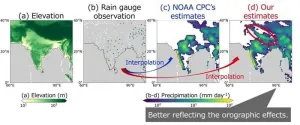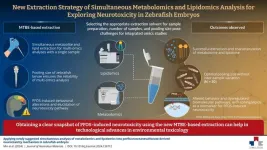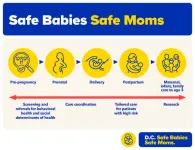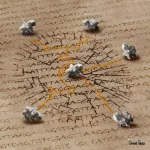Aligning Science Across Parkinson’s (ASAP) launches a new funding opportunity to join the Collaborative Research Network
2025-01-15
(Press-News.org) The Aligning Science Across Parkinson’s (ASAP) initiative opened applications for members of the research community to apply to join the Collaborative Research Network (CRN) 2025 Scientific Track. The new Scientific Track grants will support collaborative research teams focused on dissecting the mechanisms that contribute to Parkinson’s disease (PD) heterogeneity across one of six focus areas listed below, offering funding of up to $3 million per year over three years.
Examining PD in the context of aging
Understanding how co-pathologies can influence PD pathogenesis and progression
Dissecting mechanisms associated with known environmental risk factors and their contribution to disease pathogenesis
Understanding the circuit biology driving clinical symptom presentation (with an emphasis on non-motor symptoms)
Role of clearance mechanisms in PD
Identifying factors influencing seeding of the alpha-synuclein protein in the brain
Teams within the Scientific Tracks will join the ASAP CRN, an international, multidisciplinary, and multi-institutional network of collaborating investigators working to address high-priority research questions. The goal is to accelerate the pace of discovery for PD and drive new ideas into the research and development pipeline.
“Over the past four years, ASAP’s Collaborative Research Network has worked diligently to advance our understanding of Parkinson’s disease (PD), focusing on functional genomics, neuro-immune interactions, and circuitry and brain-body interactions,” said Ekemini A. U. Riley, PhD, managing director of ASAP. “This new funding opportunity allows us to expand the impact of the CRN by addressing additional knowledge gaps in PD that specifically focus on the assessment of PD heterogeneity.”
Projects supported within the scientific track must have direct relevance to human Parkinson’s disease. In addition, teams must adhere to the ASAP team composition, application, and budgetary guidelines, while committing to follow ASAP’s Open Science Policy. Letter of Intent submissions are due on March 20, 2025. ASAP will announce funding decisions in January 2026.
Learn more about the funding opportunity, access the letter of intent (LOI) instructions, and view all requirements by visiting https://parkinsonsroadmap.org/funding-opportunities/scientific-track/#
###
About
Aligning Science Across Parkinson’s is a research initiative comprised of international, multidisciplinary, and multi-institutional researchers working to address resource and knowledge gaps in the development and progression of Parkinson’s disease. ASAP is deeply rooted in the belief that we can accelerate advances by fostering a collaborative and open approach to research. ASAP is managed by the Coalition for Aligning Science and is working with The Michael J. Fox Foundation to implement its programs. For more information, visit our website and connect with us on LinkedIn, Bluesky, and Threads social media platforms.
Contact
Rosanna Vierra, GMMB
rosanna.vierra@gmmb.com
808.215.1173
END
ELSE PRESS RELEASES FROM THIS DATE:
2025-01-15
Three scientists were awarded the 2024 Kaul Foundation Prize for Excellence in Plasma Physics Research and Technology Development based on their decades of groundbreaking research about how plasma behaves in fusion reactors.
Choongseok (CS) Chang, Seung-Hoe Ku and Robert Hager of the U.S. Department of Energy’s (DOE) Princeton Plasma Physics Laboratory (PPPL) were recognized “for experimentally validated simulations of turbulence-broadened divertor heat flux widths using the X-Point Included Gyrokinetic Code (XGC),” following decades of research developing comprehensive simulations to model the fusion plasma edge.
Recently, ...
2025-01-15
The Davos Alzheimer’s Collaborative (DAC), a pioneering worldwide initiative seeking to cure Alzheimer’s disease and improve brain health, today announced the launch of its Brain Health Navigator program. The initiative led by the DAC Healthcare System Preparedness (DAC-SP) team will provide resources for patients and providers at six sites across the U.S.
Despite Alzheimer’s status as a growing worldwide epidemic, pathways for accurate diagnosis and evidence based interventions including new therapies are either underdeveloped or non-existent. ...
2025-01-15
New York, NY – Jan. 15, 2025 –We are excited to welcome you to San Francisco for the ATS 2025 International Conference! Journalists will have access to leaders, as well as emerging scientists and clinicians, who are at the forefront of medical breakthroughs and clinical innovation in pulmonary, critical care and sleep medicine.
Join us beginning Sunday, May 18* through Wednesday, May 21. Register now and check out our Program at a Glance.
As always, you are welcome to contact the ATS communications and marketing director about scientific sessions and expert interviews whether you are joining us in person or from your (home) office. Registered ...
2025-01-15
MINNEAPOLIS / ST. PAUL (01/15/2024) — A study by researchers at the University of Minnesota Twin Cities offers new insights into how alternating corn and soybean crops can help increase crop yield in a changing climate.
The research is published in the peer-reviewed scientific journal Global Change Biology.
Rising temperatures and weather extremes are threatening global food security, making it crucial to understand how sustainable practices like crop rotation can help improve agricultural yields and resilience.
The study found that the benefits to corn-soybean rotation, compared to continuous corn year after year, are extremely sensitive to ...
2025-01-15
With the increase in climate change, global precipitation estimates have become a necessity for predicting water-related disasters like floods and droughts, as well as for managing water resources. The most accurate data that can be used for these predictions are ground rain gauge observations, but it is often challenging due to limited locations and sparse rain gauge data. To solve this problem, Assistant Professor Yuka Muto from the Center for Environmental Remote Sensing, Japan, and Professor Shunji Kotsuki of the Institute for Advanced Academic Research, Center for Environmental Remote Sensing, ...
2025-01-15
The term “omics” refers to the study of entirety of molecular mechanisms that happen inside an organism. With the advent of omics technologies like transcriptomics, proteomics, metabolomics, and lipidomics, our understanding of molecular pathways of toxic environmental pollutants has deepened. But most environmental toxicology studies are still dependent on a single-omics analyses, leading to gaps in our understanding of integrated toxicity pathways of pollutants. Researchers from all over the world have ...
2025-01-15
The Tomosynthesis Mammographic Imaging Screening Trial (TMIST) has reached its enrollment goal of 108,508 women, as announced today by the ECOG-ACRIN Cancer Research Group (ECOG-ACRIN). The study, funded by the National Cancer Institute (NCI), one of the National Institutes of Health, will now proceed with the completion of regularly scheduled mammograms and follow-up on all participants through 2027. Key in this follow-up is the collection of biospecimens and data that will help researchers learn how to personalize breast cancer screening for women.
Participants in TMIST were randomly ...
2025-01-15
WASHINGTON - Women who were cared for by the MedStar Health D.C. Safe Babies Safe Moms program (SBSM) have better outcomes in pregnancy, delivery, and postpartum, according to a study published today in NEJM Catalyst Innovations in Care Delivery. Additionally, the study showed that Black patients cared for by SBSM were also less likely to have low or very low birthweight babies or preterm birth than Black or White patients who received prenatal care elsewhere.
Compared to patients who received prenatal care elsewhere, patients cared for under Safe ...
2025-01-15
Octopus arms move with incredible dexterity, bending, twisting, and curling with nearly infinite degrees of freedom. New research from the University of Chicago revealed that the nervous system circuitry that controls arm movement in octopuses is segmented, giving these extraordinary creatures precise control across all eight arms and hundreds of suckers to explore their environment, grasp objects, and capture prey.
“If you're going to have a nervous system that's controlling such dynamic movement, that's a good way to set it up,” said Clifton Ragsdale, PhD, Professor of Neurobiology at UChicago and senior author ...
2025-01-15
The three-dimensional shape of a protein can be used to resolve deep, ancient evolutionary relationships in the tree of life, according to a study in Nature Communications.
It is the first time researchers use data from protein shapes and combine it with data from genomic sequences to improve the reliability of evolutionary trees, a critical resource used by the scientific community for understanding the history of life, monitor the spread of pathogens or create new treatments for disease.
Crucially, the approach works even with the ...
LAST 30 PRESS RELEASES:
[Press-News.org] Aligning Science Across Parkinson’s (ASAP) launches a new funding opportunity to join the Collaborative Research Network







